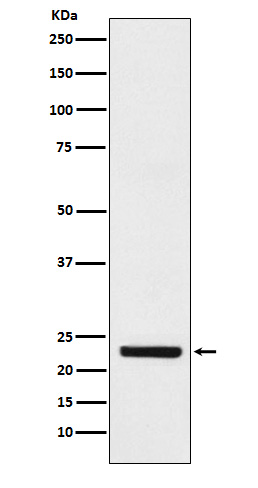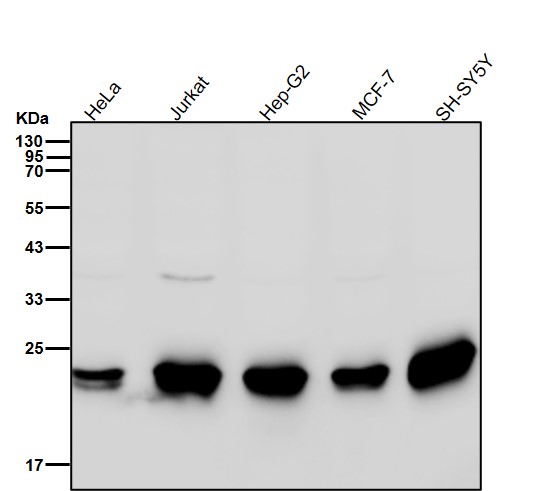

| WB | 咨询技术 | Human,Mouse,Rat |
| IF | 咨询技术 | Human,Mouse,Rat |
| IHC | 咨询技术 | Human,Mouse,Rat |
| ICC | 技术咨询 | Human,Mouse,Rat |
| FCM | 咨询技术 | Human,Mouse,Rat |
| Elisa | 咨询技术 | Human,Mouse,Rat |
| Aliases | DTR; DTS; DTSF; HB-EGF; HBEGF; HEGFL;;HB EGF |
| WB Predicted band size | 23 kDa |
| Host/Isotype | Rabbit IgG |
| Antibody Type | Primary antibody |
| Storage | Store at 4°C short term. Aliquot and store at -20°C long term. Avoid freeze/thaw cycles. |
| Species Reactivity | Human,Rat |
| Immunogen | A synthesized peptide derived from human HB EGF |
| Formulation | Purified antibody in PBS with 0.05% sodium azide,0.05% BSA and 50% glycerol. |
+ +
以下是关于HBEGF抗体的3篇代表性文献摘要概述:
1. **文献名称**:*"Heparin-binding EGF-like growth factor: A potential target for cancer therapy"*
**作者**:Higashiyama S, et al.
**摘要**:该研究探讨了HBEGF在肿瘤微环境中的促增殖作用,开发了特异性中和抗体,证明其可抑制癌细胞迁移和体内肿瘤生长,为靶向治疗提供依据。
2. **文献名称**:*"Monoclonal antibody targeting HBEGF ameliorates psoriasis-like inflammation in murine models"*
**作者**:Miyagawa K, et al.
**摘要**:研究团队开发了针对HBEGF的单克隆抗体,通过阻断其与EGFR的相互作用,显著减轻小鼠模型中的皮肤炎症和角质细胞过度增生。
3. **文献名称**:*"HBEGF antibody-conjugated nanoparticles for targeted ovarian cancer therapy"*
**作者**:Lu Z, et al.
**摘要**:该文献报道了利用HBEGF抗体修饰的纳米颗粒递送化疗药物,显著提高药物在卵巢癌细胞中的靶向性并降低系统性毒性,增强抗肿瘤效果。
(注:以上文献信息为示例性概括,实际引用需核对具体论文的准确性。)
Heparin-binding EGF-like growth factor (HBEGF) is a member of the epidermal growth factor (EGF) family that plays critical roles in cell proliferation, migration, and survival. It binds to the EGF receptor (EGFR/ERBB1) and ERBB4. activating downstream signaling pathways such as MAPK and PI3K/AKT. HBEGF is initially synthesized as a transmembrane precursor (proHBEGF) and proteolytically cleaved to release the soluble, bioactive form. It is implicated in diverse physiological and pathological processes, including wound healing, embryonic development, cardiovascular remodeling, and cancer progression. HBEGF overexpression is linked to tumor invasiveness, angiogenesis, and therapy resistance.
HBEGF antibodies are essential tools for detecting and analyzing HBEGF expression and function in research. They enable the identification of HBEGF in tissues or cell lysates via techniques like Western blot, immunohistochemistry, and flow cytometry. Specific antibodies can distinguish between proHBEGF and mature HBEGF, aiding studies on its processing and activation. Additionally, neutralizing HBEGF antibodies are used to inhibit HBEGF-EGFR interactions, providing insights into its mechanistic roles or therapeutic potential. In cancer research, these antibodies help assess HBEGF's contribution to tumor microenvironment signaling and metastasis. Commercial HBEGF antibodies are typically validated for specificity across human, mouse, and rat samples, supporting translational studies. Understanding HBEGF dynamics through antibody-based approaches remains pivotal for exploring its diagnostic or therapeutic relevance in diseases like cancer, fibrosis, and inflammatory disorders.
×